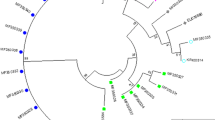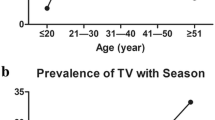Abstract
Aim
The aim of the current study is to evaluate the prevalence of trichomoniasis in men and women in the north of Iran and to find genotypes in the positive clinical specimens based on T. vaginalis actin gene.
Materials and Methods
Women’s genital (n = 500) and men’s urine (n = 1500) samples were collected from the participants referred to clinics in Mazandaran Province, northern Iran, during 2006–2018. In addition, 1500 Pap smear specimens, archived in the Bu Ali Hospital, Sari City, Mazandaran Province, northern Iran, were examined. The specimens were examined based on parasitological methods, nested polymerase chain reaction (PCR), PCR-restriction fragment length polymorphism, and phylogenetic analysis.
Results
Overall, 17 (0.48%) of 3500 specimens were positive by PCR. Total prevalence was 0.55% (n = 2000) for women, of which 500 (1.4%; n = 7) specimens were collected freshly, and 1500 (0.26%; n = 4) were Pap smears. Moreover, six (0.4%) out of 1500 men urine specimens were positive. Overall, genotypes G, E, and I were detected with the prevalence of seven (0.2%), seven (0.2%), and three (0.08%), respectively. There was no significant statistical difference among the prevalence of the detected genotypes (P > 0.05).
Conclusion
As a whole, the prevalence of trichomoniasis was low in the studied area in the north of Iran and, most importantly, the genotypes of E, G, and I were distributed among men and women in the province.




Similar content being viewed by others
References
Abou-kamar W, Abdel-Mageid A, El-Nahas H, Atia R, El-Tantawy N (2017) Genetic relatedness of Trichomonas vaginalis isolates to the clinical variability. J Mol Microbiol 1(1):103
Vos T, Barber RM, Bell B, Bertozzi-Villa A, Biryukov S, Bolliger I, Charlson F, Davis A, Degenhardt L, Dicker D, Duan L (2015) Global, regional, and national incidence, prevalence, and years lived with disability for 301 acute and chronic diseases and injuries in 188 countries, 1990–2013: a systematic analysis for the Global Burden of Disease Study 2013. Lancet 386(9995):743–800. https://doi.org/10.1016/S0140-6736(15)60692-4
Rogers SM, Turner CF, Hobbs M, Miller WC, Tan S, Roman AM, Eggleston E, Villarroel MA, Ganapathi L, Chromy JR, Erbelding E (2014) Epidemiology of undiagnosed trichomoniasis in a probability sample of urban young adults. PLoS One 9:e90548. https://doi.org/10.1371/journal.pone.0090548
Sutton M, Sternberg M, Koumans EH, McQuillan G, Berman S, Markowitz L (2007) The prevalence of Trichomonas vaginalis infection among reproductive-age women in the United States, 2001–2004. Clin Infect Dis 45(10):1319–1326. https://doi.org/10.1086/522532
Meites E, Gaydos CA, Hobbs MM, Kissinger P, Nyirjesy P, Schwebke JR, Secor WE, Sobel JD, Workowski KA (2015) A review of evidence-based care of symptomatic trichomoniasis and asymptomatic Trichomonas vaginalis infections. Clin Infect Dis 61(suppl-8):S837–S848. https://doi.org/10.1093/cid/civ738
Edwards T, Burke P, Smalley H, Hobbs G (2016) Trichomonas vaginalis: clinical relevance, pathogenicity and diagnosis. Crit Rev Microbiol 42(3):406–417. https://doi.org/10.3109/1040841X.2014.958050
Masha SC, Cools P, Sanders EJ, Vaneechoutte M, Crucitti T (2019) Trichomonas vaginalis and HIV infection acquisition: a systematic review and meta-analysis. Sex Transm Infect 95(1):36–42. https://doi.org/10.1136/sextrans-2018-053713
Yang S, Zhao W, Wang H, Wang Y, Li J, Wu X (2018) Trichomonas vaginalis infection-associated risk of cervical cancer: a meta-analysis. Eur J Obstet Gynecol Reprod Biol 228:166–173. https://doi.org/10.1016/j.ejogrb.2018.06.031
Cu-Uvin S, Ko H, Jamieson DJ, Hogan JW, Schuman P, Anderson J, Klein RS (2002) Prevalence, incidence, and persistence or recurrence of trichomoniasis among human immunodeficiency virus (HIV)-positive women and among HIV-negative women at high risk for HIV infection. Clin Infect Dis 34(10):1406–1411
Franklin TL, Monif GR (2000) Trichomonas vaginalis and bacterial vaginosis. Coexistence in vaginal wet mount preparations from pregnant women. J Reprod Med 45(2):131–134
Klinger EV, Kapiga SH, Sam NE, Aboud S, Chen CY, Ballard RC, Larsen U (2006) A Community-based study of risk factors for Trichomonas vaginalis infection among women and their male partners in Moshi urban district, northern Tanzania. Sex Transm Dis 33(12):712–718. https://doi.org/10.1097/01.olq.0000222667.42207.0
Minkoff HL, Eisenberger-Matityahu D, Feldman J, Burk R, Clarke L (1999) Prevalence and incidence of gynecologic disorders among women infected with human immunodeficiency virus. Am J Obstet Gynecol 180(4):824–836
Ertabaklar H, Ertug S, Caliskan SO, Malatyali E, Bozdogan B (2018) Use of internal transcribed spacer sequence polymorphisms as a method for Trichomonas vaginalis genotyping. Turk Parazitol Derg 42(1):6–10. https://doi.org/10.5152/tpd.2018.5503
Bradic M, Warring SD, Tooley GE, Scheid P, Secor WE, Land KM, Huang PJ, Chen TW, Lee CC, Tang P, Sullivan SA, Carlton JM (2017) Genetic indicators of drug resistance in the highly repetitive genome of Trichomonas vaginalis. Genome Biol Evol 9(6):1658–1672. https://doi.org/10.1093/gbe/evx110
Wasas AD, Huebner RE, De Blanche M, Klugman KP (1998) Long-term survival of Streptococcus pneumoniae at room temperature on Dorset egg medium. J Clin Microbiol 36(4):1139–1140
Green MR, Sambrook J (2017) Isolation of high-molecular-weight DNA using organic solvents. Cold Spring Harb Protoc. https://doi.org/10.1101/pdb.prot093450
Zhang Z, Kang L, Wang W, Zhao X, Li Y, Xie Q, Wang S, He T, Li H, Xiao T, Chen Y, Zuo S, Kong L, Li P, Li X (2018) Prevalence and genetic diversity of Trichomonas vaginalis clinical isolates in a targeted population in Xinxiang City, Henan Province, China. Parasit Vectors 11(1):018–2753. https://doi.org/10.1186/s13071-018-2753-4
Hall T, Biosciences I, Carlsbad C (2011) BioEdit: an important software for molecular biology. GERF Bull Biosci 2(1):60–61
Meade JC, de Mestral J, Stiles JK, Secor WE, Finley RW, Cleary JD, Lushbaugh WB (2009) Genetic diversity of Trichomonas vaginalis clinical isolates determined by EcoRI restriction fragment length polymorphism of heat-shock protein 70 genes. Am J Trop Med Hyg 80(2):245–251
Masha SC, Cools P, Crucitti T, Sanders EJ, Vaneechoutte M (2017) Molecular typing of Trichomonas vaginalis isolates by actin gene sequence analysis and carriage of T. vaginalis viruses. Parasit Vectors 10(1):017–2496. https://doi.org/10.1186/s13071-017-2496-7
Crucitti T, Abdellati S, Van Dyck E, Buve A (2008) Molecular typing of the actin gene of Trichomonas vaginalis isolates by PCR-restriction fragment length polymorphism. Clin Microbiol Infect 14(9):844–852. https://doi.org/10.1111/j.1469-0691.2008.02034.x
Bakhtiari A, Hajian-Tilaki K, Pasha H (2008) Genital infection by Trichomonas Vaginalis in women referring to Babol health centers: prevalence and risk factors. Iran Red Crescent Med J 10(1):16–21
Taghizadeh H, Taghizadeh F, Fathi M, Reihani P, Shirdel N, Rezaee SM (2015) Drug use and high-risk sexual behaviors of women at a drop-in center in Mazandaran Province, Iran, 2014. Iran J Psychiatry Behav Sci 9(2):1. https://doi.org/10.17795/ijpbs1047
Piwonka H, Butcher R, Smeltzer J, Doyle B, Smart H, Cockrell A (2016) 2: comparison of three methods for diagnosis of Trichomonas vaginalis infections. Am J Obstet Gynecol 215(6):S827
Perazzi BE, Menghi CI, Coppolillo EF, Gatta C, Eliseth MC, de Torres RA, Vay CA, Famiglietti AM (2010) Prevalence and comparison of diagnostic methods for Trichomonas vaginalis infection in pregnant women in Argentina. Korean J Parasitol 48(1):61–65. https://doi.org/10.3347/kjp.2010.48.1.61
Momeni Z, Sadraei J, Kazemi B, Dalimi A (2015) Molecular typing of the actin gene of Trichomonas vaginalis isolates by PCR-RFLP in Iran. Exp Parasitol 159:259–263. https://doi.org/10.1016/j.exppara.2015.10.011
Acknowledgements
The vice chancellor of research at the Mazandaran University of Medical Sciences supported this study with a grant (Code: 6101).
Author information
Authors and Affiliations
Corresponding author
Ethics declarations
Conflict of Interest
The authors declare that they have no conflict of interest.
Additional information
Publisher's Note
Springer Nature remains neutral with regard to jurisdictional claims in published maps and institutional affiliations.
Rights and permissions
About this article
Cite this article
Ziaei Hezarjaribi, H., Taghavi, M., Hasanjani Saravi, K. et al. Actin Gene-Based Molecular Typing of Trichomonas vaginalis Clinical Isolates from the North of Iran. Acta Parasit. 65, 859–864 (2020). https://doi.org/10.2478/s11686-020-00226-x
Received:
Accepted:
Published:
Issue Date:
DOI: https://doi.org/10.2478/s11686-020-00226-x




